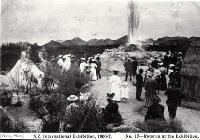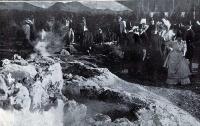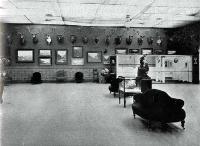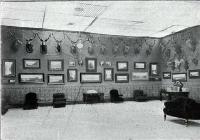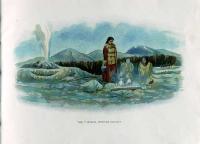Department of Tourist and Health Resorts Court
- The Department of Tourist and Health Resorts Court provided a space where the major "tourist attractions" of New Zealand could be promoted.
- At this time New Zealand’s thermal areas and Māori culture were seen as a drawcard, so these were highlighted along with sporting activities such as hunting and fishing.
New Zealand’s Tourist Appeal
The Canterbury Times called the Department of Tourist and Health Resorts Court "one of the most artistically pleasing"1 at the Exhibition. Green in colour, with touches of orange, and a muslin-lined ceiling, the Court occupied 3240 square feet (301 square metres) of floor space. Its walls were adorned with a huge selection of paintings and photographs of New Zealand scenery and illustrations of Māori life. Featured on its wall as well were the antlered heads of over 100 red deer and mounted specimens of trout.
On display were cases of kauri gum in all shades of colour, a series of ornamental timber specimens, examples of Māori carving, and a replica bath and dressing room from the Rotorua Government Baths. These exhibits reflected the priorities of the Department in this period in promoting New Zealand as a tourist destination: its thermal baths at Rotorua and in Hanmer Springs, the marketing of Māori arts and crafts, and as a mecca for hunting and game sports.
Thermal wonders
The Department’s preoccupation with advertising New Zealand’s thermal attractions was further reinforced by its outdoor exhibit, located in a small, manuka-fenced enclosure at the back of the Main Building. This area contained a "land of sulphur and wai-arikis, geysers and steam-holes"2. Dr. A.S. Wohlmann, the government balneologist at the Rotorua spa, created a replica of the Rotorua thermal area, complete with a rush-built Māoriwhare, "working" geyser, hot pools, volcano, sulphur and steam.
The geyser was a replica of Waikite Geyser in Whakarewarewa, and continually exuded vapour, which burst forthat regular intervals. It was formally opened by Lady Ward, and was (most inappropriately, given its distance from the central North Island thermal area) named ’Awarua’ in honour of Premier Joseph Ward’s Southland electorate. A six-foot (1.8 metre) high mud volcano with bubbling mud in its crater top emitted "menacing roars".
Meanwhile "wahines in native costume"3 demonstrated the "interesting culinary"4 method of cooking potatoes and kumara in ketein steam-cooking holes. The Exhibition’s restaurants also used the steam-holes for the preparation of hams and puddings. A great attraction was the warm bathing pool, surrounded by silica rocks, and occupied by Māori children from the Pa, who dived for coins thrown by tourists, "in orthodox Rotorua fashion".5
![]()
Related photos
Sources
- Cowan, J. Official record of the New Zealand International Exhibition of Arts and Industries held at Christchurch, 1906-7, page 141-147
- "Geyser Display", The Weekly Press, 7 November 1906, page 110
- "Tourist Department", Canterbury Times, 7 November 1906, page 29
Related links
Footnotes
- [1] "Tourist Department", Canterbury Times, 7 November 1906, page 29
- [2] Cowan, J. Official record, page 145
- [3] "Geyser Display", The Weekly Press, 7 November 1906, page 110
- [4] "Geyser Display", The Weekly Press, 7 November 1906, page 110
- [5] "Geyser Display", The Weekly Press, 7 November 1906, page 110




